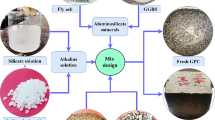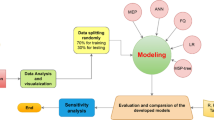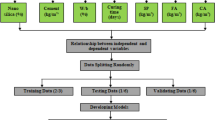Abstract
Geopolymers are innovative cementitious materials that can completely replace traditional Portland cement composites and have a lower carbon footprint than Portland cement. Recent efforts have been made to incorporate various nanomaterials, most notably nano-silica (nS), into geopolymer concrete (GPC) to improve the composite’s properties and performance. Compression strength (CS) is one of the essential properties of all types of concrete composites, including geopolymer concrete. As a result, creating a credible model for forecasting concrete CS is critical for saving time, energy, and money, as well as providing guidance for scheduling the construction process and removing formworks. This paper presents a large amount of mixed design data correlated to mechanical strength using empirical correlations and neural networks. Several models, including artificial neural network, M5P-tree, linear regression, nonlinear regression, and multi-logistic regression models, were utilized to create models for forecasting the CS of GPC incorporated with nS. In this case, about 207 tested CS values were collected from literature studies and then analyzed to promote the models. For the first time, eleven effective variables were employed as input model parameters during the modeling process, including the alkaline solution to binder ratio, binder content, fine and coarse aggregate content, NaOH and Na2SiO3 content, Na2SiO3/NaOH ratio, molarity, nS content, curing temperatures, and ages. The developed models were assessed using different statistical tools such as root mean squared error, mean absolute error, scatter index, objective function value, and coefficient of determination. Based on these statistical assessment tools, results revealed that the ANN model estimated the CS of GPC incorporated with nS more accurately than the other models. On the other hand, the alkaline solution to binder ratio, molarity, NaOH content, curing temperature, and ages were those parameters that have significant influences on the CS of GPC incorporated with nS.



























Similar content being viewed by others
Data availability
Not applicable.
References
Abdel-Gawwad HA, Abo-El-Enein SA (2016) A novel method to produce dry geopolymer cement powder. HBRC Journal 12(1):13–24. https://doi.org/10.1016/j.hbrcj.2014.06.008
Abdullah WA, Ahmed HU, Alshkane YM, Rahman DB, Ali AO, Abubakr SS (2021) The possibility of using waste PET plastic strip to enhance the flexural capacity of concrete beams. J Eng Res 9. https://doi.org/10.36909/jer.v9iICRIE.11649
Adak D, Sarkar M, Mandal S (2017) Structural performance of nano-silica modified fly-ash based geopolymer concrete. Constr Build Mater 135:430–439. https://doi.org/10.1016/j.conbuildmat.2016.12.111
Ahmed HU, Mohammed AA, Rafiq S, Mohammed AS, Mosavi A, Sor NH, Qaidi S (2021b) Compressive strength of sustainable geopolymer concrete composites: a state-of-the-art review. Sustainability 13(24):13502. https://doi.org/10.3390/su132413502
Ahmed HU, Mohammed AS, Mohammed AA, Faraj RH (2021c) Systematic multiscale models to predict the compressive strength of fly ash-based geopolymer concrete at various mixture proportions and curing regimes. PLoS ONE 16(6):e0253006. https://doi.org/10.1371/journal.pone.0253006
Ahmed HU, Faraj RH, Hilal N, Mohammed AA, Sherwani AFH (2021a) Use of recycled fibers in concrete composites: a systematic comprehensive review. Compos B Eng 108769. https://doi.org/10.1016/j.compositesb.2021a.108769
Ahmed HU, Mohammed AA, Mohammad AS (2022) The role of nanomaterials in geopolymer concrete composites: a state-of-the-art review. J Build Eng 104062. https://doi.org/10.1016/j.jobe.2022.104062
Aliabdo AA, Abd Elmoaty M, Salem HA (2016) Effect of water addition, plasticizer and alkaline solution constitution on fly ash based geopolymer concrete performance. Constr Build Mater 121:694–703. https://doi.org/10.1016/j.conbuildmat.2016.06.062
Angelin Lincy G, Velkennedy R (2020) Experimental optimization of metakaolin and nanosilica composite for geopolymer concrete paver blocks. Struct Concr. https://doi.org/10.1002/suco.201900555
Assaedi H, Shaikh FUA, Low IM (2016) Influence of mixing methods of nano silica on the microstructural and mechanical properties of flax fabric reinforced geopolymer composites. Constr Build Mater 123:541–552. https://doi.org/10.1016/j.conbuildmat.2016.07.049
Behfarnia K, Rostami M (2017) Effects of micro and nanoparticles of SiO2 on the permeability of alkali activated slag concrete. Constr Build Mater 131:205–213. https://doi.org/10.1016/j.conbuildmat.2016.11.070
Çevik A, Alzeebaree R, Humur G, Niş A, Gülşan ME (2018) Effect of nano-silica on the chemical durability and mechanical performance of fly ash based geopolymer concrete. Ceram Int 44(11):12253–12264. https://doi.org/10.1016/j.ceramint.2018.04.009
Davidovits J (2015) Geopolymer chemistry and applications. 4-th edition. J. Davidovits.–Saint-Quentin, France
Deb PS, Nath P, Sarker PK (2014) The effects of ground granulated blast-furnace slag blending with fly ash and activator content on the workability and strength properties of geopolymer concrete cured at ambient temperature. Mater Des 1980–2015(62):32–39. https://doi.org/10.1016/j.matdes.2014.05.001
Demircan E, Harendra S, Vipulanandan C (2011) Artificial neural network and nonlinear models for gelling time and maximum curing temperature rise in polymer grouts. J Mater Civ Eng 23(4):372–377. https://doi.org/10.1061/(ASCE)MT.1943-5533.0000172
Emad H, Soufi W, Elmannaey A, Abd-El-Aziz M, Hany EG (2018) Effect of nano-silica on the mechanical properties of slag geopolymer concrete
Etemadi M, Pouraghajan M, Gharavi H (2020) Investigating the effect of rubber powder and nano silica on the durability and strength characteristics of geopolymeric concretes. Journal of civil Engineering and Materials Application 4(4):243–252. https://doi.org/10.22034/jcema.2020.119979
Faraj RH, Mohammed AA, Mohammed A, Omer KM, Ahmed HU (2021) Systematic multiscale models to predict the compressive strength of self-compacting concretes modified with nanosilica at different curing ages. Eng Comput 1-24. https://doi.org/10.1007/s00366-021-01385-9
Faraj RH, Ahmed HU, Sherwani AFH (2022) Fresh and mechanical properties of concrete made with recycled plastic aggregates. In Handbook of sustainable concrete and industrial waste management (pp. 167–185). Woodhead Publishing. https://doi.org/10.1016/B978-0-12-821730-6.00023-1
Ghafoor MT, Khan QS, Qazi AU, Sheikh MN, Hadi MNS (2021) Influence of alkaline activators on the mechanical properties of fly ash based geopolymer concrete cured at ambient temperature. Constr Build Mater 273:121752. https://doi.org/10.1016/j.conbuildmat.2020.121752
Gholampour A, Mansouri I, Kisi O, Ozbakkaloglu T (2020) Evaluation of mechanical properties of concretes containing coarse recycled concrete aggregates using multivariate adaptive regression splines (MARS), M5 model tree (M5Tree), and least squares support vector regression (LSSVR) models. Neural Comput Appl 32(1):295–308. https://doi.org/10.1007/s00521-018-3630-y
Golafshani EM, Behnood A (2018) Application of soft computing methods for predicting the elastic modulus of recycled aggregate concrete. J Clean Prod 176:1163–1176. https://doi.org/10.1016/j.jclepro.2017.11.186
Golafshani EM, Behnood A, Arashpour M (2020) Predicting the compressive strength of normal and high-performance concretes using ANN and ANFIS hybridized with grey wolf optimizer. Constr Build Mater 232:117266. https://doi.org/10.1016/j.conbuildmat.2019.117266
Hamah Sor N, Hilal N, Faraj RH, Ahmed HU, Sherwani AFH (2021) Experimental and empirical evaluation of strength for sustainable lightweight self-compacting concrete by recycling high volume of industrial waste materials. European Journal of Environmental and Civil Engineering 1-18. https://doi.org/10.1080/19648189.2021.1997827
Hardjito D, Wallah SE, Sumajouw DM, Rangan BV (2004) On the development of fly ash-based geopolymer concrete. Materials Journal 101(6):467–472
Hassan A, Arif M, Shariq M (2019) Effect of curing condition on the mechanical properties of fly ash-based geopolymer concrete. SN Applied Sciences 1(12):1–9. https://doi.org/10.1007/s42452-019-1774-8
Ibrahim M, Johari MAM, Maslehuddin M, Rahman MK (2018a) Influence of nano-SiO2 on the strength and microstructure of natural pozzolan based alkali activated concrete. Constr Build Mater 173:573–585. https://doi.org/10.1016/j.conbuildmat.2018.04.051
Ibrahim M, Johari MAM, Rahman MK, Maslehuddin M, Mohamed HD (2018b) Enhancing the engineering properties and microstructure of room temperature cured alkali activated natural pozzolan based concrete utilizing nanosilica. Constr Build Mater 189:352–365. https://doi.org/10.1016/j.conbuildmat.2018.08.166
Ibrahim M, Rahman MK, Johari MAM, Maslehuddin M (2018c) Effect of incorporating nano-silica on the strength of natural pozzolan-based alkali-activated concrete. In International Congress on Polymers in Concrete (pp. 703–709). Springer, Cham. https://doi.org/10.1007/978-3-319-78175-4_90
Janaki AM, Shafabakhsh G, Hassani A (2021) Laboratory evaluation of alkali-activated slag concrete pavement containing silica fume and carbon nanotubes. Eng J 25(5):21–31. https://doi.org/10.4186/ej.2021.25.5.21
Jindal BB, Parveen, Singhal D, Goyal A (2017) Predicting relationship between mechanical properties of low calcium fly ash-based geopolymer concrete. Trans Indian Ceram Soc 76(4):258–265. https://doi.org/10.1080/0371750X.2017.1412837
Kotop MA, El-Feky MS, Alharbi YR, Abadel AA, Binyahya AS (2021) Engineering properties of geopolymer concrete incorporating hybrid nanomaterials. Ain Shams Eng J.https://doi.org/10.1016/j.asej.2021.04.022
Lazaro A, Yu QL, Brouwers HJH (2016) Nanotechnologies for sustainable construction. In Sustainability of construction materials (pp. 55–78). Woodhead Publishing
Mahasenan N, Smith S, Humphreys K (2003) The cement industry and global climate change: current and potential future cement industry CO2 emissions. In Greenhouse Gas Control Technologies-6th International Conference (pp. 995–1000). Pergamon
Mahboubi B, Guo Z, Wu H (2019) Evaluation of durability behavior of geopolymer concrete containing nano-silica and nano-clay additives in acidic media. Journal of civil Engineering and Materials Application 3(3):163–171. https://doi.org/10.22034/JCEMA.2019.95839
Malerba D, Esposito F, Ceci M, Appice A (2004) Top-down induction of model trees with regression and splitting nodes. IEEE Trans Pattern Anal Mach Intell 26(5):612–625. https://doi.org/10.1109/TPAMI.2004.1273937
Mohammed AS (2018) Vipulanandan models to predict the electrical resistivity, rheological properties and compressive stress-strain behavior of oil well cement modified with silica nanoparticles. Egypt J Pet 27(4):1265–1273. https://doi.org/10.1016/j.ejpe.2018.07.001
Mohammed AA, Ahmed HU, Mosavi A (2021) Survey of mechanical properties of geopolymer concrete: a comprehensive review and data analysis. Materials 14(16):4690. https://doi.org/10.3390/ma14164690
Mustakim SM, Das SK, Mishra J, Aftab A, Alomayri TS, Assaedi HS, Kaze CR (2020) Improvement in fresh, mechanical and microstructural properties of fly ash-blast furnace slag based geopolymer concrete by addition of nano and micro silica. Silicon 1-14. https://doi.org/10.1007/s12633-020-00593-0
Naskar S, Chakraborty AK (2016) Effect of nano materials in geopolymer concrete. Perspect Sci 8:273–275. https://doi.org/10.1016/j.pisc.2016.04.049
Nuaklong P, Sata V, Wongsa A, Srinavin K, Chindaprasirt P (2018) Recycled aggregate high calcium fly ash geopolymer concrete with inclusion of OPC and nano-SiO2. Constr Build Mater 174:244–252. https://doi.org/10.1016/j.conbuildmat.2018.04.123
Nuaklong P, Jongvivatsakul P, Pothisiri T, Sata V, Chindaprasirt P (2020) Influence of rice husk ash on mechanical properties and fire resistance of recycled aggregate high-calcium fly ash geopolymer concrete. J Clean Prod 252:119797. https://doi.org/10.1016/j.jclepro.2019.119797
Oyebisi S, Ede A, Olutoge F, Omole D (2020) Geopolymer concrete incorporating agro-industrial wastes: effects on mechanical properties, microstructural behaviour and mineralogical phases. Constr Build Mater 256:119390. https://doi.org/10.1016/j.conbuildmat.2020.119390
Patel Y, Patel IN, Shah MJ (2015) Experimental investigation on compressive strength and durability properties of geopolymer concrete incorporating with nano silica. International Journal of Civil Engineering and Technology 6(5):135–143
Provis JL, Palomo A, Shi C (2015) Advances in understanding alkali-activated materials. Cem Concr Res 78:110–125. https://doi.org/10.1016/j.cemconres.2015.04.013
Qaidi SM, Tayeh BA, Zeyad AM, de Azevedo AR, Ahmed HU, Emad W (2022) Recycling of mine tailings for the geopolymers production: a systematic review. Case Studies in Construction Materials e00933. https://doi.org/10.1016/j.cscm.2022.e00933
Quinlan Ross J (1992) Learning with continuous classes. In: 5th Australian Joint Conference on Artificial Intelligence, Singapore, pp. 343–348
Rabiaa E, Mohamed RAS, Sofi WH, Tawfik TA (2020) Developing geopolymer concrete properties by using nanomaterials and steel fibers. Adv Mater Sci Eng 2020. https://doi.org/10.1155/2020/5186091
Ravitheja A, Kumar NK (2019) A study on the effect of nano clay and GGBS on the strength properties of fly ash based geopolymers. Materials Today: Proceedings 19:273–276. https://doi.org/10.1016/j.matpr.2019.06.761
Roco MC, Williams RS, Alivisatos P (Eds.) (2000) Nanotechnology research directions: IWGN workshop report: vision for nanotechnology in the next decade. Springer Science & Business Media
Saini G, Vattipalli U (2020) Assessing properties of alkali activated GGBS based self-compacting geopolymer concrete using nano-silica. Case Studies in Construction Materials 12:e00352. https://doi.org/10.1016/j.cscm.2020.e00352
Sastry KGK, Sahitya P, Ravitheja A (2021) Influence of nano TiO2 on strength and durability properties of geopolymer concrete. Materials Today: Proceedings 45:1017–1025. https://doi.org/10.1016/j.matpr.2020.03.139
Shahmansouri AA, Yazdani M, Ghanbari S, Bengar HA, Jafari A, Ghatte HF (2020b) Artificial neural network model to predict the compressive strength of eco-friendly geopolymer concrete incorporating silica fume and natural zeolite. J Clean Prod 279:123697. https://doi.org/10.1016/j.jclepro.2020.123697
Shahmansouri AA, Bengar HA, Ghanbari S (2020a) Compressive strength prediction of eco-efficient GGBS-based geopolymer concrete using GEP method. J Build Eng 101326. https://doi.org/10.1016/j.jobe.2020a.101326
Shahrajabian F, Behfarnia K (2018) The effects of nano particles on freeze and thaw resistance of alkali-activated slag concrete. Constr Build Mater 176:172–178. https://doi.org/10.1016/j.conbuildmat.2018.05.033
Shaikh FUA (2016) Mechanical and durability properties of fly ash geopolymer concrete containing recycled coarse aggregates. Int J Sustain Built Environ 5(2):277–287. https://doi.org/10.1016/j.ijsbe.2016.05.009
Sharif HH (2021) Fresh and mechanical characteristics of eco-efficient geopolymer concrete incorporating nano-silica: an overview. Kurdistan Journal of Applied Research, 64–74. https://doi.org/10.24017/science.2021.2.6
Sihag P, Jain P, Kumar M (2018) Modelling of impact of water quality on recharging rate of storm water filter system using various kernel function based regression. Modeling Earth Systems and Environment 4(1):61–68. https://doi.org/10.1007/s40808-017-0410-0
Their JM, Özakça M (2018) Developing geopolymer concrete by using cold-bonded fly ash aggregate, nano-silica, and steel fiber. Constr Build Mater 180:12–22. https://doi.org/10.1016/j.conbuildmat.2018.05.274
Velay-Lizancos M, Perez-Ordoñez JL, Martinez-Lage I, Vazquez-Burgo P (2017) Analytical and genetic programming model of compressive strength of eco concretes by NDT according to curing temperature. Constr Build Mater 144:195–206. https://doi.org/10.1016/j.conbuildmat.2017.03.123
Vyas, S., Mohammad, S., Pal, S., & Singh, N. (2020). Strength and durability performance of fly ash based geopolymer concrete using nano silica. International Journal of Engineering Science Technologies, 4(2), 1–12. https://doi.org/10.29121/ijoest.v4.i2.2020.73
Weil M, Dombrowski K, Buchwald A (2009) Life-cycle analysis of geopolymer. In Geopolymers (pp. 194–210). Woodhead Publishing. https://doi.org/10.1533/9781845696382.2.194
Wiesner MR, Bottero JY (2017) Environmental nanotechnology: applications and impacts of nanomaterials. McGraw-Hill Education. https://www.accessengineeringlibrary.com/content/book/9780071828444
Yildirim G, Sahmaran M, Ahmed HU (2015) Influence of hydrated lime addition on the self-healing capability of high-volume fly ash incorporated cementitious composites. J Mater Civ Eng 27(6):04014187. https://doi.org/10.1061/(ASCE)MT.1943-5533.0001145
Author information
Authors and Affiliations
Contributions
Hemn Unis Ahmed (corresponding author): idea of concept; planning; validation; resources; data curation; writing—original draft; writing—review and editing for this manuscript.
Ahmed S. Mohammed: planning, validation; resources; data curation; writing—review for this manuscript.
Azad A. Mohammed: planning and designing; validation; writing—review for this manuscript.
Corresponding author
Ethics declarations
Ethical approval
Not applicable.
Consent to participate
Not applicable.
Consent to publication
Not applicable.
Competing interests
The authors declare no competing interests.
Additional information
Responsible Editor: Philippe Garrigues
Publisher's note
Springer Nature remains neutral with regard to jurisdictional claims in published maps and institutional affiliations.
Rights and permissions
About this article
Cite this article
Ahmed, H.U., Mohammed, A.S. & Mohammed, A.A. Proposing several model techniques including ANN and M5P-tree to predict the compressive strength of geopolymer concretes incorporated with nano-silica. Environ Sci Pollut Res 29, 71232–71256 (2022). https://doi.org/10.1007/s11356-022-20863-1
Received:
Accepted:
Published:
Issue Date:
DOI: https://doi.org/10.1007/s11356-022-20863-1




